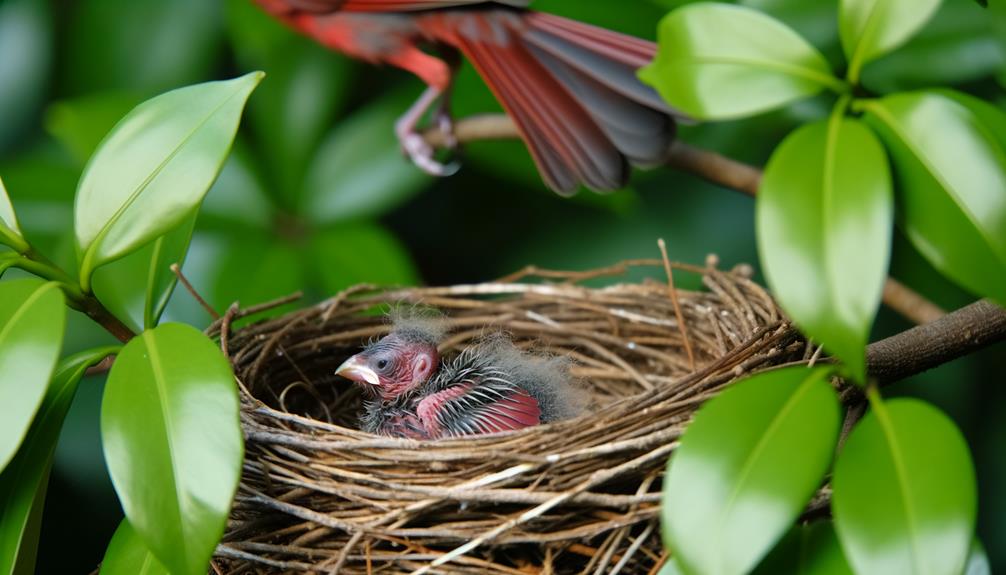Signs Baby Cardinal Doesn’t Look Ready to Fledge
Your baby cardinal might fledge even if it doesn't seem fully prepared. Typically, cardinals leave the nest within 9-11 days, showing increased wing strength and motor skills.
Watch for frequent wing flapping and coordinated hopping, which indicate developing musculature. Parents also play an essential role, often encouraging fledging with vocalizations and reduced feeding.
While the bird's appearance might suggest otherwise, fledging decisions often align with survival instincts and parental signals. For a deeper understanding of these intricate behaviors and environmental influences, explore further.

Key Takeaways
- Parental encouragement behaviors, such as feeding outside the nest, can indicate fledging readiness even if the baby cardinal appears underdeveloped.
- Increased wing flapping frequency and strength are critical indicators of fledging readiness, despite the bird's appearance.
- Coordinated movements like hopping and perching stability show developing motor skills necessary for fledging.
- Fledglings might leave the nest due to instinctual drives before looking ready, relying on parental guidance for survival.
- Safety concerns, such as predator threats or environmental conditions, may force premature fledging despite apparent unreadiness.
Cardinal Fledgling Basics
Although they may appear delicate, baby cardinal fledglings exhibit remarkable resilience and rapid progress during their initial weeks of life.
Observational data indicates that fledglings typically leave the nest within 9-11 days post-hatching. During this period, their weight increases exponentially, and their primary flight feathers grow significantly.
You'll notice that fledglings start practicing essential survival skills such as hopping and short flights under parental supervision. Their diet, consisting mainly of insects and seeds, supports their accelerated growth and energy needs.
Behavioral studies show that fledglings display innate predator avoidance tactics, including remaining motionless and blending into their surroundings.
Identifying Fledging Signs
When observing baby cardinals, you should look for key fledging signs such as increased wing strength, which is essential for sustained flight.
You'll also notice more coordinated movements, indicating the fledgling's growing motor skills.
Additionally, watch for parental encouragement behaviors, like feeding outside the nest, which signals readiness for independence.
Wing Strength Development
Observing a baby cardinal's wing flapping frequency and strength provides vital data for identifying the onset of fledging. You should take detailed notes on the intensity and duration of wing flapping.
Increased frequency and stronger, more sustained flapping indicate developing musculature, essential for flight readiness. Record the number of flaps per minute and note any attempts at lift-off. Analyze these behaviors daily, looking for a consistent upward trend.
Comparing these metrics against established fledging timelines for cardinals can offer predictive insights. Guarantee your data collection is systematic, perhaps using video recordings for accuracy. By correlating wing strength with known fledging stages, you'll understand better when a baby cardinal is truly ready to leave the nest.
Coordinated Movements Observation
You should meticulously track the baby cardinal's coordinated movements, such as hopping and perching, to pinpoint critical signs of fledging readiness. Observing these movements allows you to gather data on motor skills and balance, which are essential for successful fledging.
Key behaviors to monitor include:
- Hopping Frequency: Increased and consistent hopping without faltering.
- Perching Stability: Ability to perch for extended periods without losing balance.
- Wing-Flapping Coordination: Simultaneous wing and leg movements that suggest muscle synchronization.
- Flight Attempts: Short, controlled flights from one perch to another, indicating developing flight muscles.
Parental Encouragement Signs
Parental encouragement cues, such as the adult cardinals' frequent vocalizations and physical nudges, are critical indicators that fledging is imminent. You'll notice the adults chirping persistently near the nest, signaling the young to prepare. These vocalizations are often coupled with gentle nudges or even slight pecks, urging the fledglings to take their first flight. Observing these behaviors provides insight into the readiness of the baby cardinal to fledge.
Here's a summary of these signs:
| Sign Type | Description | Emotional Impact |
|---|---|---|
| Vocalizations | Persistent chirping near the nest | Sense of urgency |
| Physical Nudges | Gentle pushes or pecks | Encouragement and care |
| Feeding Changes | Less frequent feeding | Independence promotion |
| Nest Departure | Adults leaving the nest area | Readiness confirmation |
| Wing Flapping | Increased wing exercises | Preparation for flight |
Understanding these signs helps ensure the fledgling's successful shift.
Early Development Stages
In the early development stages, baby cardinals undergo rapid growth and exhibit significant changes in behavior and physiology. You'll notice these transformations through careful observation.
Key developmental milestones include:
- Feather Growth: Downy feathers are replaced by juvenile feathers, enabling better thermoregulation.
- Feeding Behavior: Initially dependent on regurgitated food, they gradually start to peck at solid food.
- Mobility: From barely moving, they progress to hopping and wing-flapping, which are precursors to flight.
- Vocalization: Soft begging calls evolve into more distinct chirps, aiding in communication with parents.
These stages are critical for their survival and ability to eventually fledge. Tracking these changes helps you understand whether a baby cardinal is truly ready to leave the nest.
Parental Roles and Duties
You'll observe that both male and female cardinals share nest-building tasks, with the female primarily constructing while the male gathers materials.
Data shows feeding intervals occur approximately every 30 minutes, ensuring best nutrition for the fledglings.
Protective behaviors, such as aggressive displays by the male, are critical for deterring predators and safeguarding the nest.
Nest Building Responsibilities
Both male and female cardinals exhibit distinct roles during nest building, with the female primarily constructing the nest while the male gathers materials and guards the territory. This division of labor ensures efficiency and safety.
Observations indicate that:
- Material Gathering: Male cardinals collect twigs, leaves, and grasses.
- Nest Construction: Female cardinals meticulously weave these materials into a sturdy structure.
- Territorial Defense: Males aggressively protect the nesting area from predators and rival males.
- Site Selection: Females choose hidden, secure locations within dense foliage.
Data analysis shows that this cooperative behavior increases offspring survival rates. By comprehending these roles, you gain insight into cardinal nesting strategies, emphasizing the precision and dedication both parents invest in their reproductive success.
Feeding and Nutrition
During the early stages of a baby cardinal's life, understanding the distinct feeding responsibilities of each parent is essential for grasping their nutritional development.
The male cardinal primarily gathers food, focusing on seeds, insects, and fruits. Observational data indicates that male cardinals make approximately 8-10 food trips per hour, guaranteeing a steady supply. Nutrient-dense diets, rich in proteins and fats, are critical during this phase.
Meanwhile, the female remains at the nest, feeding the hatchlings with regurgitated nourishment. The female's role in breaking down food guarantees that the chicks can easily digest it. This division of labor optimizes the chicks' growth rates, ensuring they receive essential nutrients for robust fledging.
Understanding these roles highlights the intricate dynamics of cardinal parenting.
Protecting the Nest
As the baby cardinals grow, the parents intensify their vigilance, employing a range of defensive strategies to safeguard the nest from potential predators. You'll observe a significant increase in their protective behaviors. They take turns monitoring the surroundings, ensuring no threat goes unnoticed.
Chasing intruders: Both parents will aggressively chase away any approaching predators, including other birds and small mammals.
Alarm calls: They utilize a series of sharp, distinctive alarm calls to warn each other and scare off potential threats.
Nest fortification: The parents often add more leaves and twigs to further conceal the nest.
Decoy tactics: One parent may distract predators by feigning injury, drawing them away from the nest.
These combined efforts are essential to the survival of their young.
Nesting Environment
The nesting environment for baby cardinals typically includes dense shrubbery or low tree branches, providing necessary cover and protection from predators. You'll notice that these areas offer ample foliage, which helps conceal the nest from potential threats.
Observational data shows that a well-chosen nesting site can greatly increase fledging success rates. Cardinals often select locations with a mix of vegetation, ensuring structural support and adequate shelter from weather elements.
By analyzing nesting patterns, researchers have found that cardinals prefer spots with minimal human disturbance. It's important to understand that the microhabitat's complexity directly influences the chicks' survival chances.
Therefore, the quality and safety of the nesting environment play a crucial role in preparing baby cardinals for eventual fledging.
Flight Preparation
In the weeks leading up to fledging, baby cardinals engage in vigorous wing flapping and hopping exercises to build the strength and coordination necessary for their first flight. You'll observe these behaviors as pivotal milestones in their development. Data shows that these activities are essential for muscle development and neural coordination.
- Wing Flapping: Repeated, rapid movement increases muscle mass and endurance.
- Hopping: Short, controlled jumps enhance balance and spatial awareness.
- Perch Training: Practicing perching on various surfaces aids in gripping and stability.
- Sibling Interaction: Engaging with nestmates fosters competitive and cooperative skills.
Common Fledging Challenges
Despite the rigorous preparation, baby cardinals frequently encounter difficulties such as disorientation, predation risks, and inadequate flight control during their initial attempts at fledging.
You may observe fledglings showing signs of spatial disorientation, often resulting in erratic flight patterns. Data indicates that up to 50% of fledglings fall prey to predators like cats and hawks within the first week.
Inadequate flight control is common, with young birds often struggling to achieve stable flight trajectories. Observational studies highlight that fledglings often land in exposed areas, increasing their vulnerability.
These challenges underscore the precarious nature of the fledging period. Understanding these obstacles can help you better appreciate the critical early stages of a cardinal's life.
Survival Instincts
Baby cardinals exhibit remarkable survival instincts that are essential for maneuvering through the dangers of their fledging period.
You'll notice several key behaviors that enhance their chances of survival:
- Camouflage: Their plumage blends with the environment, reducing visibility to predators.
- Silent Movement: They limit noise, which decreases detection risk by predators.
- Rapid Response: When threatened, they exhibit quick, reactive movements to evade danger.
- Parental Guidance: Parents provide continuous signals and cues to navigate their environment.
These behaviors are crucial during the fledging phase, where vulnerability is at its peak.
Observational data indicate that fledglings with more pronounced survival instincts have higher survival rates.
The intricacies of these behaviors highlight the importance of innate and learned responses in avian developmental stages.
Safety Precautions
You should implement predator awareness measures, as data show that fledglings face significant risks from predators.
Guarantee the nest location offers security by being well-concealed and structurally stable.
Additionally, monitor weather conditions closely, since adverse weather can impact fledgling survival rates.
Predator Awareness Measures
Ensuring the fledgling's safety involves implementing predator awareness measures that include strategic nest placement and monitoring environmental changes. You'll need to contemplate several factors to maximize protection from potential predators.
Here are four critical steps:
- Elevate Nests: Position nests at least 10 feet above ground to deter ground predators.
- Use Camouflage: Integrate natural materials to blend the nest with its surroundings, reducing visibility to predators.
- Monitor Activity: Regularly observe the nest area for any signs of predatory behavior or disturbances.
- Predator Guards: Install barriers such as baffles around the tree or structure to prevent access by climbing predators.
Nest Location Security
To maximize nest location security, consider positioning the nest within dense greenery to greatly diminish the chances of predator detection. Dense greenery offers camouflage and a physical barrier against predators. Studies show that nests hidden in thick vegetation have a 40% higher survival rate than those in open areas.
Select locations near prickly shrubs or dense tree canopies, as these provide additional layers of protection. Observe the local habitat to identify high-traffic predator zones and avoid these areas. Ensure the nest is at a peak height, around 5-10 feet above ground, to deter ground-based threats.
Regularly monitor the nest for signs of disturbance, and if necessary, relocate to a safer, more hidden location.
Weather Condition Considerations
While nest location security is crucial, considering weather conditions is equally important to guarantee the fledglings' safety and well-being.
Adverse weather can greatly impact a baby cardinal's survival rate. By evaluating meteorological data, you can anticipate potential threats.
- Temperature Extremes: Both high and low temperatures can stress fledglings. Make sure temperatures are within a suitable range.
- Precipitation Levels: Heavy rain can lead to hypothermia and increased predation risk. Monitor forecasts to avoid fledging during storms.
- Wind Speeds: Strong winds can displace or harm fledglings. Evaluate wind speeds to ensure they're below hazardous thresholds.
- Humidity Levels: High humidity can worsen respiratory issues. Aim for moderate humidity to promote optimal fledgling health.
Human Interventions
Many human interventions, like offering safe nesting areas and extra feeding, can greatly enhance the survival rates of fledgling baby cardinals. By setting up predator-proof nest boxes, you can reduce predation risks. Observational data indicates that fledging success rates improve by up to 40% in such controlled environments.
Extra feeding, particularly during food scarcity, offers important nutritional support. Studies have shown that fledglings receiving additional food have a 30% higher survival rate. Make sure that the provided food mimics their natural diet, focusing on seeds and insects.
It's crucial to minimize human scent and disturbance around the nest to avoid attracting predators. By using these evidence-based strategies, you're giving fledgling cardinals a significantly better chance at successful fledging.
Encouraging Natural Behavior
Providing support for fledgling baby cardinals is essential, but it's equally important to encourage natural behaviors that enhance their survival skills.
Observational data indicates that fledglings benefit from environments where they can practice innate behaviors. Here's how you can facilitate this:
- Minimize Human Interaction: Limit direct contact to reduce reliance on humans.
- Create a Safe Habitat: Ensure the environment has dense foliage and natural cover to imitate their natural habitat.
- Provide Natural Food Sources: Scatter seeds and insects to promote foraging behavior.
- Monitor From Afar: Use binoculars or cameras to observe without disrupting their natural routines.
Conclusion
In observing cardinal fledglings, you'll recognize that fledging readiness hinges on various factors. From their parental roles to the nesting environment, every element plays a part.
Their survival instincts kick in, urging them to fledge even if they don't seem prepared. By minimizing human interventions and promoting natural behavior, you guarantee these fledglings develop essential survival skills.
Analyzing their early stages and identifying fledging signs will offer insights, helping to foster a safer, more natural progression.






